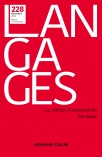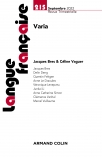
Langages n° 208 (4/2017)
Pour acheter ce numéro, contactez-nous
Recevez les numéros de l'année en cours et accédez à l'intégralité des articles en ligne.
Cette étude remonte à l’apparition de la scripturalité à Rome. Elle nous apprend à quel point une synergie entre langue parlée et langue écrite assura pendant longtemps la survie du latin et comment, faute d’un rééquilibrage entre les deux, le latin se scinda en deux systèmes linguistiques distincts. En montrant quelle importance les Romains attachèrent à l’oralité dans la création, la diffusion et la réception d’une oeuvre littéraire, cette analyse confirme l’intérêt de la distinction entre « oralité médiale » et « oralité conceptionnelle » (Koch & Oesterreicher 1985). C’est à travers des indices oraux indirects que le latin se révèle être « une langue comme toutes les autres » (Koch 1998) : il se prête encore aujourd’hui à une analyse en termes d’oralité et nous aide à comprendre selon quel mode il faut lire l’évolution du rapport fluctuant entre langue écrite et langue orale en latin pour appréhender la naissance de l’ancien français.
This study goes back to the appearance of scripturality in Rome. We will learn to which extent a synergy between orality and literacy ensured the survival of Latin for a long time, and how, in the absence of a new balance between both, Latin split into two distinct linguistic systems. By showing how important the Romans considered the voicing of text in the creation, diffusion and reception of literary works, this analysis confirms the value of the distinction between “medial orality” and “conceptual orality” (Koch & Oesterreicher 1985). It is through indirect oral clues that Latin appears to be “a language like all others” (Koch 1998) : even today it lends itself to an analysis in terms of orality, and helps us to understand how we should read the changing relationship between written and spoken language in Latin in order to apprehend the birth of old French.

